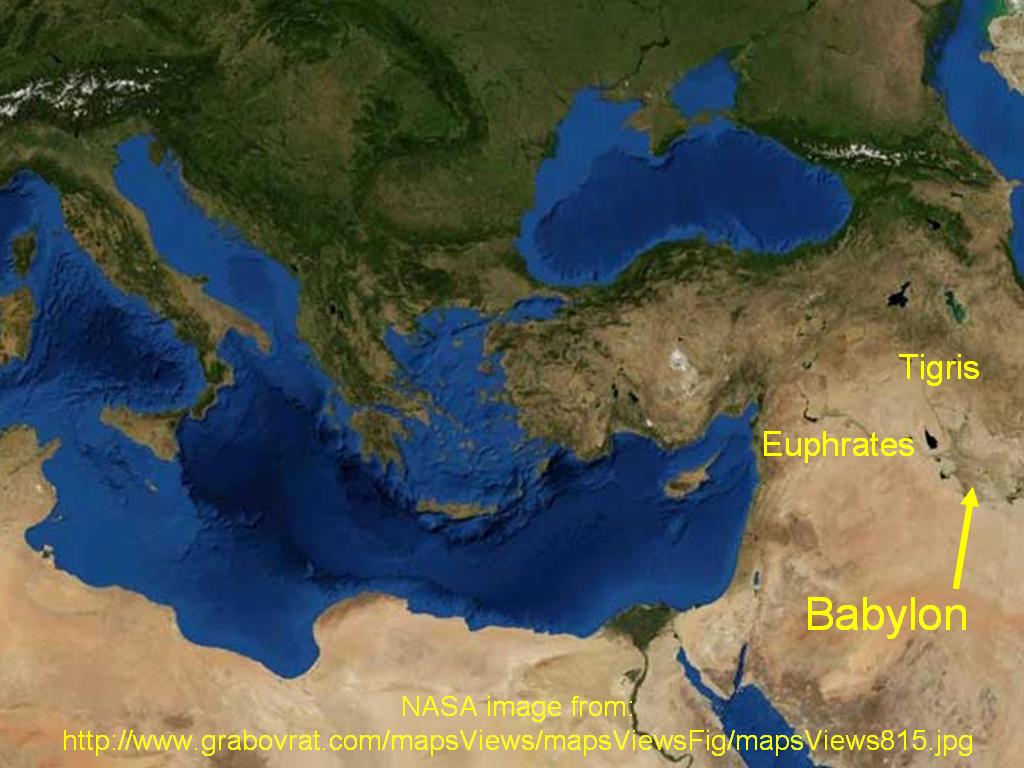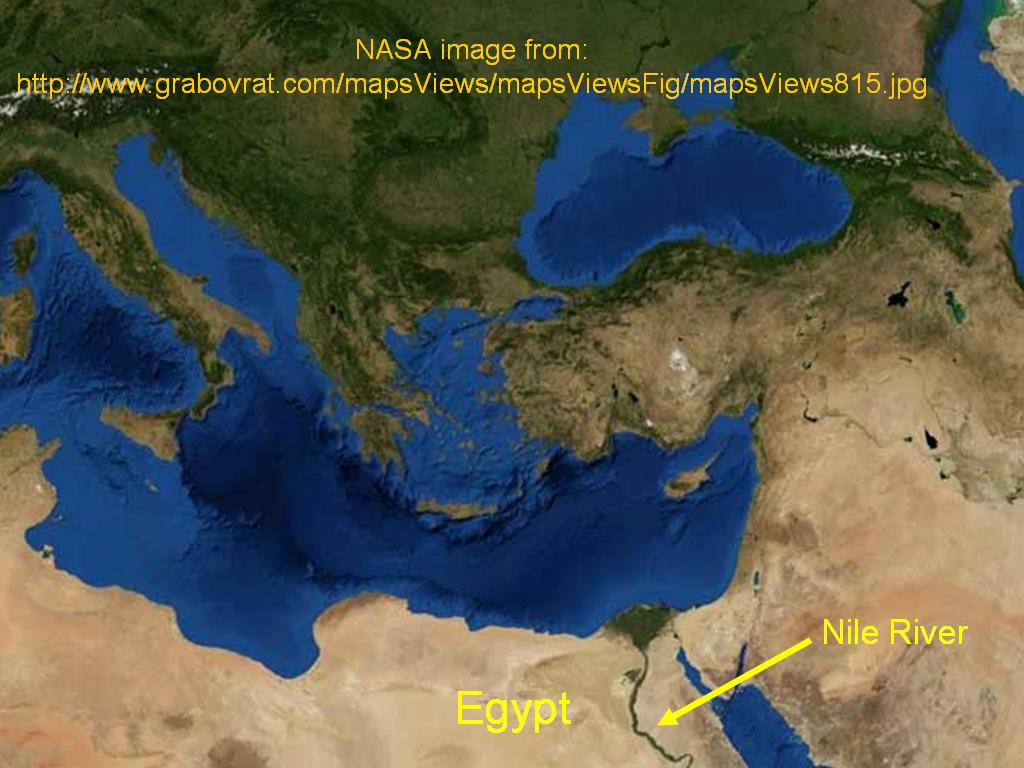Euclid's Elements - A 2,500 Year History
Bob Gardner
East Tennessee State University
Department of Mathematics and Statistics
Johnson City, TN 37614
Geometry Before Euclid

Image from The MacTutor History of Mathematics archive.
Geometry by no means began with Euclid. In the centuries preceding Euclid, there were many societies in both the East and West which were familiar with certain geometric ideas, including the Pythagorean Theorem. In the Mediterranean, there were many geometers which predated Euclid's time of 300 BCE.
 The ancient city of Babylon was located in the southern part of Mesopotamia, about 50 miles south of present day Baghdad, Iraq. Clay tablets containing a type of writing called "cuneiform" survive from Babylonian times, and some of them reflect that the Babylonians had a sophisticated knowledge of certain mathematical ideas, some geometric and some arithmetic [Bardi, page 28].
The ancient city of Babylon was located in the southern part of Mesopotamia, about 50 miles south of present day Baghdad, Iraq. Clay tablets containing a type of writing called "cuneiform" survive from Babylonian times, and some of them reflect that the Babylonians had a sophisticated knowledge of certain mathematical ideas, some geometric and some arithmetic [Bardi, page 28].
The best known surviving tablet with mathematical content is known as Plimpton 322. This tablet contains a list of Pythagorean triples, revealing some knowledge of the Pythagorean Theorem, as well as certain algebraic identities. This table also includes a list of ratios which would correspond to the cosecant of an angle of a right triangle determined by the triples. This feature of the tablet makes it the oldest known trigonometric table. This tablet is estimated to be between 1900 and 1600 BCE [Moar, page 8].
 The Egyptians also had a working knowledge of geometry.
The annual flooding of the Nile River erased boundaries between different plots of land on the river front. This required the Egyptians to apply geometry to measure the land on the flood plain to determine who owned which land. This river front property was used for agriculture and people were taxed based on their area of the land they farmed. So it was vital to the society to accurately perform this surveying.
The Egyptians also had a working knowledge of geometry.
The annual flooding of the Nile River erased boundaries between different plots of land on the river front. This required the Egyptians to apply geometry to measure the land on the flood plain to determine who owned which land. This river front property was used for agriculture and people were taxed based on their area of the land they farmed. So it was vital to the society to accurately perform this surveying.

Image from Wikipedia.
The techniques used are revealed in the papyrus titled "Direction for Obtaining Knowledge of All Dark Things." It contains a number of math problems, was written by a scribe named Ahmes and dates from around 1650 BCE [Bardi, pages 26 and 27]. It is sometimes called the Rhind Mathematical Papyrus. However, the Egyptians were pragmatic with their geometry and did not advance the subject into the theoretical area.

Thales of Miletus (624 BCE – 524 BCE (circa))
Image from The MacTutor History of Mathematics archive.
Tradition has it that the first person to become involved in the proving of theorems is Thales. He is from the coastal town of Miletus in modern-day Turkey.

Image of Thales from The MacTutor History of Mathematics archive.
He visited Egypt, learned some geometry there, and is said to have measured the height of the great pyramid of Giza by measuring lengths of shadows. Pythagoras visited Thales as a young man and based on this visit decided to go to Egypt himself. However, much of the information on Thales is speculative and should be taken with a grain of salt [Bardi, pages 29, 30, and 31]!

Pythagoras of Samos (569 BCE – 475 BCE (circa))
Image from The MacTutor History of Mathematics archive.
After Euclid, the most famous mathematician of the ancient world is Pythagoras. He was born around 570 BCE and grew up in a thriving culture at the beginning of the blooming of classical Greek civilization.
 He was born on the island of Samos, off the west coast of modern-day Turkey. He also lived in Babylon, spent time in Egypt, and settled in Croton in southern Italy. In Croton, he established his well-known Pythagorean school around 530 BCE.
He was born on the island of Samos, off the west coast of modern-day Turkey. He also lived in Babylon, spent time in Egypt, and settled in Croton in southern Italy. In Croton, he established his well-known Pythagorean school around 530 BCE.

Image from http://thespiritguides.ning.com/profile/GoldenFlower (a new age site)
The Pythagorean school was more like a religious sect than a modern-day academic institute. The Pythagoreans vowed to keep their discoveries secret and there is no written record of their work. [Moar, page 17]
The Pythagorean's avoided wine and meat, and, most famously, forbade the eating of beans or any food that caused flatulence [Bardi, page 36].

Pythagoras as depicted in Raphael's The School of Athens
Image from http://students.roanoke.edu/groups/relg211/johnson/Pythagoras.htm.
In addition to his well-known theorem (which was likely a result of the Pythagorean school, but possibly not due to Pythagoras himself), Pythagoras plays a very fundamental role in the history of mathematics. He was the first person to really put abstract reasoning into mathematics. He set geometry on a path from which it would never turn back [Bardi, page 37]. After his death around 475 BCE, the member of his school scattered and the intellectual center of mathematics shifted from Italy to Greece [Bardi, page 41].
We mention one final pre-Euclidean geometer. Hippocrates of Chios (not to be confused with Hippocrates of Cos, the physician), wrote the first geometry textbook. He introduced "proof by contradiction," also called
reductio ad absurdum [Bardi, page 42]. He studied the classical construction problems of squaring the circle and duplicating the cube. For the first time, he gave the area of a round figure by finding the area of a lune in terms of the area of a related triangle.
Go to the next section: Euclid.
Last revised November 14, 2009.














